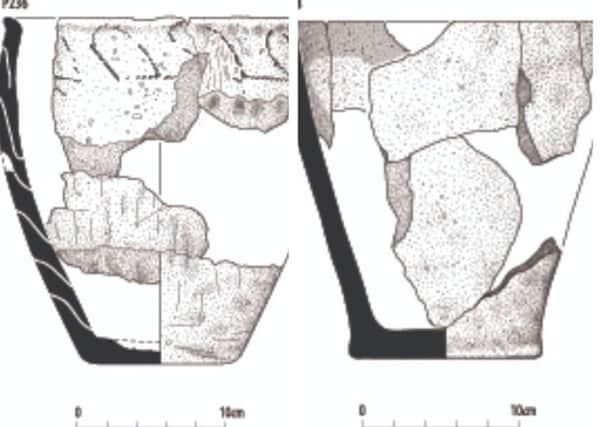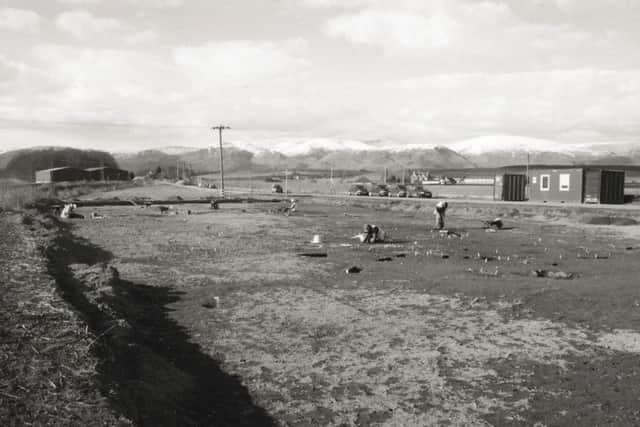Scotland's largest haul of prehistoric pottery found


The pottery was found on land at Meadowend Farm near Clackmannan, with the final report into the excavation now revealing details of the staggering collection of eating bowls and cooking vessels.
Tossed away by our ancient ancestors, the fragments of pottery reveal elusive details about their lifestyle with analysis concluding their diet may have included yoghurt, butter and cheese as well as roasted hazelnuts and toasted barley.
Advertisement
Hide AdAdvertisement
Hide AdThe collection of pottery spans more than 2,000 years with the oldest piece of pottery dating to around 4,000 BC.


Archaeologists from Headland Archeology examined the farmland ahead of the construction of the northern approach road for the Clackmannan Bridge.
Julie Franklin, the Finds, Publications and Archiving Manager at Headland Archaeology said: “The pieces were in such good condition and they just kept coming. We wondered when it was going stop.
“Normally you might come across some sherds or a couple of larger pieces but we had so much of the stuff.
Advertisement
Hide AdAdvertisement
Hide Ad“When we knew most of the pots were Neolithic, we knew we had found something important.
“It was the biggest collection of this kind of neolithic pottery ever found in Scotland.”
More than 2,000 sherds of pottery were found across two fields, where archaeologists discovered rubbish pits dug by its earliest-known occupants.
While Neolithic homes made from biodegradable and natural materials disappeared back into the landscape over time, it is these rubbish pits that hold the clues to human life thousands of years ago,
Advertisement
Hide AdAdvertisement
Hide AdIt is known that the site was occupied during both Neolithic and Bronze Age times, with evidence of six roundhouses from the latter period also discovered.
The collection of pottery dates from the first quarter of the 4th millennium BC to the last quarter of the 2nd millennium BC.
The bulk of the finds were Middle Neolithic ‘Impressed Ware’, which date from around 3300BC to 3000BC, with the pieces adding up to the largest collection from this era ever found in this country.
Research suggests the pots may have been locally, given that one of the materials used in the vessels - crushed quartz dolerite - is found close to the site.
Advertisement
Hide AdAdvertisement
Hide AdMs Franklin said; “We don’t understand the organisation of the Neolithic pottery industry that well but it was really quite finely made.”
A substantial number of pots were likely used for cooking, with charred hazelnut shells, oats and burnt cereal grains found across the site.
Analysis of a round-bottomed carinated bowl found at the site shows the vessel once contained milk-derived fats.
A report from Headland Archaeology said: “This discovery is in line with results for virtually all the other CB pottery analysed in Britain (ibid), and demonstrates once more that Scotland’s early farmers were dairy farmers, exploiting their domesticated cattle not only for their meat but also for their secondary products.”
Advertisement
Hide AdAdvertisement
Hide AdThe report added that, while Neolithic people of the area were likely lactose intolerant, they would likely have been able to digest milk in processed form, such as yoghurt, butter and cheese.
In theory, they may have been using butter for cooking, researchers said.
The full analysis of the 2006 dig has just been released by Headland Archaeology.
Ms Franklin added: “We were dealing with a settlement from which we had a lot of remains that just happened to be well preserved.
“It was a very valuable and well preserved site
Advertisement
Hide AdAdvertisement
Hide Ad“It was relatively close to the river on a bit of land that gently slopes up from the Forth.
“It would have been quite useful farmland and the proximity to the river would have been useful for fishing and for contacts with far away people.
“You can see it would have been a nice place to live.”
